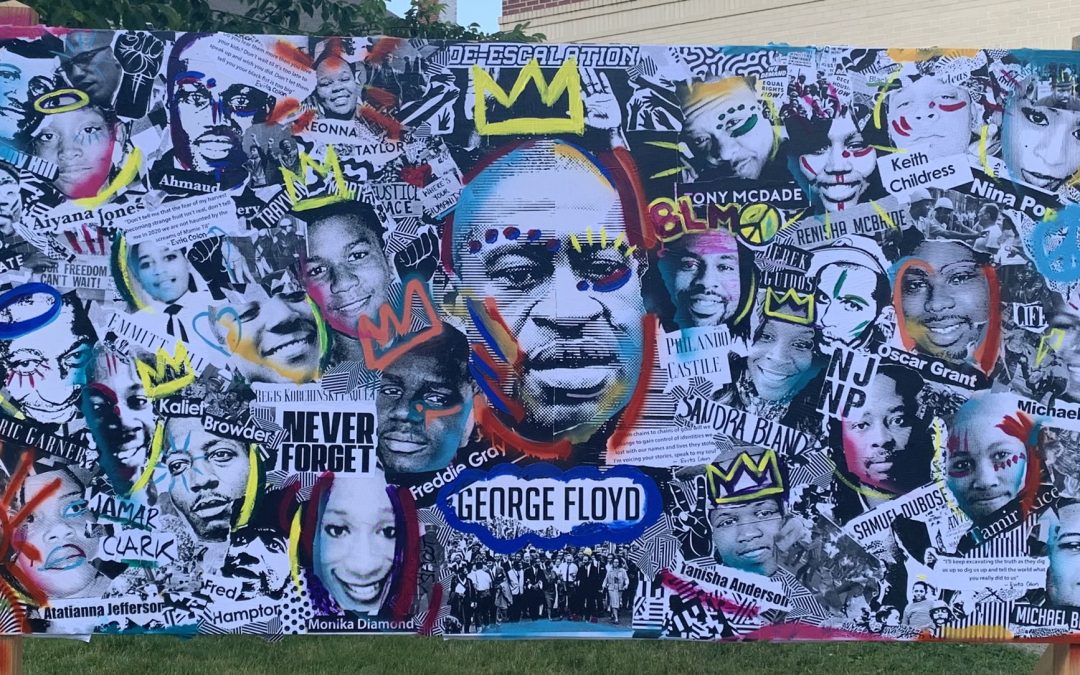By D.E. Bradley
Social media and newspaper reports are full of images of street art and graffiti related to the Black Lives Matter protests. For better or worse, these images capture the imagination and draw us into the story. Street art can help protesters and mourners make the most of the situation, using the right image, in the right place.
Putting a Face to a Cause
The artwork that has gained the most attention is, unsurprisingly, the memorials to George Floyd. The most recognizable memorial right now is probably the one in Minneapolis outside the store where the incident took place. This one is made all the more powerful with the names of others that lost their lives. There are many more across the United States, with some depicting George as an angel. One is in the neighborhood where he grew up in Houston. In fact, portraits of George have appeared all across the world. There is one in a Dublin housing estate in Ireland, one on ruins in Syria, and one in Nairobi, Kenya.
Putting a face to a campaign or political statement is always a helpful way to get noticed. This is why there are even more street art depictions of Donald Trump across the world. Some say he has a look that is made for caricature, and artists don’t hold back. The creation of the Trump Blimp Baby in the UK one of the most well-known examples to date.
The Importance of the Slogan
Then there is the snappy tagline to the protest that forms the chants and condenses the message into a few simple words. The ongoing unrest and protests across the world have seen a few examples appearing in various forms. Many memorials and pieces of street art are accompanied by phrases like “I can’t breathe,” “Stop Racism” and “Black Lives Matter.” Of course, the power of social media means that these tags and slogans are also simple hashtags. These then project the artwork from the walls of neighborhoods to the mobile devices of countless allies across the world.
The Power of a Simple Image
The power of street art and graffiti in difficult times in America is not unprecedented. With global movement that won’t be silenced, the images are repeated more frequently. There are plenty of other recent examples of the power of street art too. If we take two very different incidents – the terrorist attack in Manchester in 2017 and the recent uprising in Hong Kong – we see the power of a symbol. Manchester was adorned with bees, an icon of the city, to show the strength of the people. Hong Kong’s Umbrella Revolution has led to the simple image of the yellow umbrella. They aren’t the first and they won’t be the last.
Negative Graffiti Overshadows Positive Street Art
Images and pieces of street art can be a highly valuable tool during these times. The best become meeting points for local mourners or symbols of hope or resistance. But then there is the problem of graffiti and tagging. There will be many cases of graffiti and tagging during these protests. In some cases, it is just a kid with a spray can trying to add their own message. But, many of these incidents are considered to be acts vandalism against the properties of innocent residents and business owners. A small minority that lashes out to make a point and turns a protest into a riot could end up using graffiti to cheapen the impact of street art.
An example of this is an incident in London. Black Lives Matter protesters took to the streets in what was a pretty peaceful march. But, one incident made headline news after protesters sprayed the acronym ACAB on a memorial statue. The next morning, young members of the Household Cavalry left their barracks to clean it off and were verbally abused on camera. It is imperative that we make the distinction between street art and graffiti during times of trouble, conflict, and protest.
We have seen time and time again how a strong piece of street art from a gifted artist can express a heartfelt sentiment. It can bring people together and inspire others. Images and ideas are repeated in homage and solidarity. The image helps to promote the story. But, graffiti is too often a spontaneous, personal attack that divides us and becomes its own story, distracting us from the real issue. Street art will always have its place in times like these. Graffiti will inevitably follow. It is up to us to shine a light on the images that best serve us.






